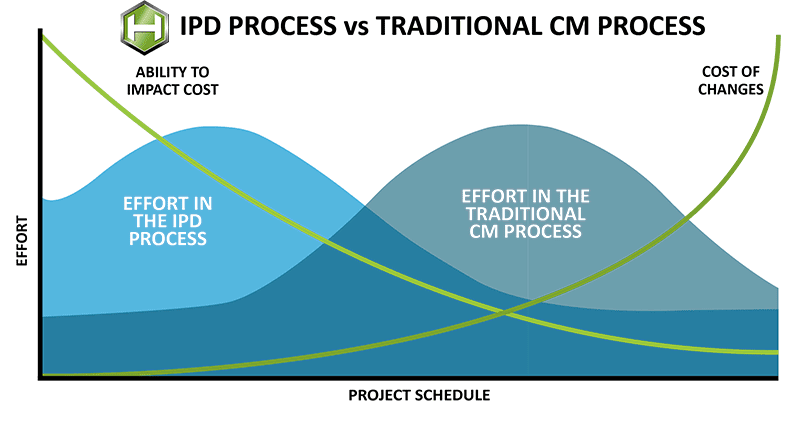 For those outside the construction industry, hearing terminology related to different project delivery methods can be quite confusing. Although each method has pros and cons, gathering the facts about various methods can quickly help you narrow down your choices to find the method that is right for you.
For those outside the construction industry, hearing terminology related to different project delivery methods can be quite confusing. Although each method has pros and cons, gathering the facts about various methods can quickly help you narrow down your choices to find the method that is right for you.
Integrated Project Delivery (IPD) is a relatively new methodology that was developed based on the alarming fact that productivity and efficiency in construction have been declining since the 1960s, according to information from the US Department of Labor and the US Bureau of Economic Analysis[i]. Many experts in the industry attribute these productivity woes to a lack of concise and open communication among project stakeholders – including the owner, designer, builder, engineer, and major subcontractors.
At its essence, Integrated Project Delivery or IPD is a method designed to attack the construction process at its weak spot – communication.
WHAT IS INTEGRATED PROJECT DELIVERY (IPD)?
IPD is a process that brings all the project’s stakeholders together early to clearly establish a vision for the project and layout the plan to collaboratively achieve that vision.
At the beginning of the project, the owner selects the project team prior to design. This team of project stakeholders gets together to clarify the vision, share expertise and suggestions, and make decisions together. The knowledge each stakeholder brings to the table during the early planning process helps prevent the creeping costs and extended schedules that sometimes plague owners during later project stages. By integrating lean principles, this team can use their expertise to maximize value and increase efficiency, looking for ways to constantly improve the project throughout the process.
This means a bit more time and effort upfront but ensures a collaborative approach that allows your selected team to get on the same page early on and work out any potential issues early in the process. By generating a synergistic team of stakeholders, you more effectively design and plan a project, and greatly reduce or eliminate the need for expensive and time-consuming change orders that must be made once the project is underway.
The IPD process unites key individuals from different firms with different expertise into one team with one clear vision.
WHO MAKES UP THE IPD TEAM?
 In most cases, IPD teams are made up of a few key players. At a minimum, the team will include the lead design firm, the lead construction firm, and the owner. The design firm brings its design expertise, the construction firm brings its construction expertise, and the owner brings expertise for how the project will impact their company, church, or organization. In some instances, the IPD team may include other firms that contribute an added level of expertise, like engineers and specialty contractors such as HVAC, plumbing, or excavation.
In most cases, IPD teams are made up of a few key players. At a minimum, the team will include the lead design firm, the lead construction firm, and the owner. The design firm brings its design expertise, the construction firm brings its construction expertise, and the owner brings expertise for how the project will impact their company, church, or organization. In some instances, the IPD team may include other firms that contribute an added level of expertise, like engineers and specialty contractors such as HVAC, plumbing, or excavation.
If you’re interested in an IPD approach for your construction project, a good place to start is by evaluating the factors that could make your project challenging. For example, if you’re planning to add new floors on top of an existing building, the expertise of a structural engineer will be essential to your project. You’ll want to bring them to the table early to get their insights and contributions.
An important component of selecting a team for an IPD project is choosing a builder and a designer that have a strong reputation for collaboration and relationship building. Click here to find out how Horst Construction creates successful partnerships with architects and engineers.
HOW IS IPD DIFFERENT FROM TRADITIONAL CONSTRUCTION METHODS?
If you’ve ever been involved in a construction project before, you probably know that planning plays a big role in setting your project up for success. So how is IPD different from the traditional way of doing things?
IPD’s main difference is the timing of the planning, and who the planning is done with. In a traditional construction project, the architect works with the owner to design the project, and then the owner works with the construction manager or general contractor to turn that design into a reality. While this approach can and has worked for many owners in the past, it does have some cons and may not be the most efficient delivery method for every project.
The traditional method has the lead designer working independently with the owner to design the project in somewhat of a vacuum. They design the project based on the needs and wants of the owner, but do not necessarily have the latest knowledge of construction costs, methods, restrictions, and alternatives.
Next, the builder comes on board and brings a very different perspective. That perspective may not have full understanding of the project intentions and vision, nor the background information that led to certain design decisions. Ultimately, this sequence of events can lead to necessary changes to design or planning, impacting the owner’s cost and schedule. The work of designers and builders are not mutually exclusive. In fact, they are highly dependent on one another! If these two firms aren’t on the same page, that could mean changes and delays. Not only does this muddy and slow the process, but it can end up costing money – sometimes a significant amount.
That’s where IPD changes the script for a project’s early-stage planning. By getting everyone together at the very beginning of the project, the architect, contractor, and owner can each contribute their expertise to form a solid plan together that will get the project up and running. And while this may take more work upfront, changes made in these early planning stages have much less of an impact on the project than changes made further along in the schedule.
To sum it all up, IPD requires more collaborative effort at the beginning of the project, but this extra effort happens when the cost of changes to the project is low. With the traditional CM process, the most collaborative effort is during the later stages of the project, when changes are likely to push back a project’s schedule and cost the owner much more money.
WHAT DOES AN IPD CONTRACT LOOK LIKE?
In order to motivate different firms to get on the same page and bring their very best, they need to have skin in the game. A common way IPD teams achieve this level of commitment is through a multi-party agreement or an MPA. If you want to get a feel for what one of these looks like, check out the Consensus Doc 300.
What is an MPA? An MPA is a single contract between the contributing firms. The contract clearly outlines the roles, responsibilities, and rights of each firm, and compensation is dependent on the overall success of the project.
IPD holds both the design team and construction team accountable for the success of the entire project, not just the success of their portion of the project. This helps make each member dedicated to not only doing the best they can with their responsibilities but for contributing their expertise to all the stages of the project.
WHAT ARE THE BENEFITS OF IPD?
To put it simply, projects that utilize IPD can finish faster and cost less than projects that don’t. With the collaborative expertise of the design team, construction team, and any other essential stakeholders early in the construction process, you’ll end up with a project plan that can proceed with fewer issues. By facilitating a lean approach, there is often more efficient use of labor, time, and resources. There will be fewer surprise changes as the project develops. While an IPD approach can’t guarantee that your project will be issue-free, it will help start your project off best foot forward.
Overall, an IPD approach will increase the productivity of your team, and you’ll be rewarded with a quicker and more cost-effective project.
Oops! We could not locate your form.
[i] http://www.leanconstruction.org/media/docs/PEJune14_Construction.pdf



